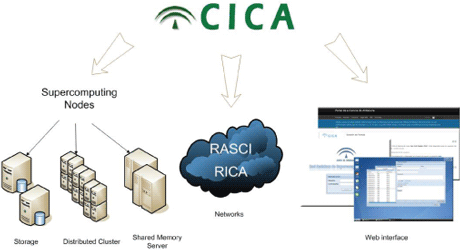The Andalusian Scientific Computing Centre (CICA) is a supercomputing centre in Andalusia that provides supercomputing nodes and the Andalusian e-Science Portal to RASCI (see Figure 1).

CICA Infrastructure
Currently, CICA has a distributed cluster. It consists of a set of nodes with Intel Core 2 Duo or Intel Quad Core CPUs and 4 GB or 8 GB of RAM, connected through gigabit ethernet. The batch systems installed are the Sun Grid Engine (SGE) and Condor interface. At present, the Web interface application allows users to queue their jobs into Condor and SGE for subsequent execution by the cluster.
CICA promotes the use of open-source software, and the supercomputing nodes run under Linux, make use of open-source libraries and utilities, and use several OS.
The Andalusian Supercomputing Network will allow nodes located at different universities and research centres to be joined together in a unified computing system. To achieve this, a technical committee (for infrastructure management), an access committee (for access management) and a strategic committee have been established.
Other services are offered by CICA to users of the Andalusian Supercomputing Network, including assistance in parallelizing applications to take advantage of the Grid infrastructure. This involves providing programming courses, expert advice and consultancy for optimization and parallelization of applications and the use of message-passing libraries for the efficient use of distributed memory. With these services CICA intends to increase the number of users who can potentially take advantage of the supercomputing infrastructure, rather than limiting its use to those who are already technically proficient (see Figure 2).

All of this makes it possible to bring supercomputing technology to a heterogeneous community, allowing for faster technological progress, and also to increase the demand for this type of service, due to its simplicity of use.
Web Interface
Rather than being graphical or accessible through a Web interface, cluster queue manager interfaces tend to be accessed through a command line interface from a Linux or Windows console.
Different interfaces have been developed for the Condor queue manager, each with a specific purpose depending on who is making use of it. One of the services to which this queue manager's developers have contributed is the use of Web services (SOAP-WSDL). For its implementation they have developed the BirdBath package, which, by means of WSDL calls, allows jobs in the cluster to be submitted and managed. The main inconvenience presented by these calls is the ease of discovery and indexation by search engine Web crawlers, since they are accessible though URLs. They can thus be found and stored through search engines. Moreover, the management capabilities are limited to the functionalities implemented by BirdBath developers.
The architecture presented by the CICA-named Cluster Looking Class (CLG) allows the user to make use of resources through the Web, eliminating the need to enter commands through a command line console. This ease of use extends the reach of computing services to a greater number of users as a technical profile is no longer required. At present, this interface is operational at the Andalusian e-Science Portal, giving registered users access to computational resources connected to the Andalusian Computing scientific Network (RICA) and Andalusian Supercomputing Network (RASCI).
However, with the ability to access the system through the Web, security becomes a critical aspect. In a system such as this, the high level of computing power turns it into a very powerful tool for illicit uses such as brute-force password cracking. In order to avoid this problem, CLG defines both a logical and a physical architecture that allows the user to manage and submit jobs and to receive their results, uncoupling the physical architecture of the cluster from the Web interface and thus putting an end to security problems.
Further Work
In the future, the supercomputing resources of CICA will grow and will be included in this infrastructure. Our estimation is that this will lead to bigger massive storage, shared memory servers, more distributed nodes and new batch systems.
Links:
Andalusian e-Science portal: https://eciencia.cica.es
Condor Project HTC: http://www.cs.wisc.edu/condor
Please contact:
Juan Antonio Ortega
Centro Informático Científico de Andalucía, Spain
E-mail: ortega![]() cica.es
cica.es










